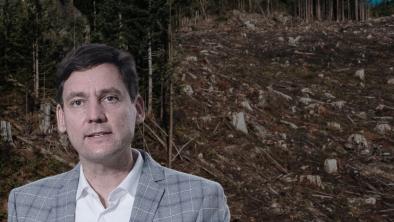Update from the Field: Wilderness Committee Visits the Legendary Walbran Valley

Wilderness Committee’s Vancouver Island Campaigner with the Castle Giant – one of the largest red cedar trees in Canada – in the Walbran Valley
Traditionally, the summer months of July and August are the peak of our Wilderness Committee field season. On Vancouver Island, the torrential rains that keep our rainforests alive let up a little, and visits to key areas are possible waking up to find your campsite has turned into a pond overnight.
A week and a half ago, I went out in the field with some volunteers to one of my favourite places — southern Vancouver Island’s Walbran Valley. Sixty-five kilometres on logging roads southwest of Lake Cowichan, the Walbran is remote, but not inaccessible. Twenty years ago we worked hard to protect a portion of the Walbran and the neighbouring Carmanah Valley. However, the groves around Walbran Falls, where some of the largest, most ecologically important forest stands, were excluded from the park boundary.
A map showing the borders of Carmanah-Walbran Provincial Park, and the old-growth areas that were left out of the park.
This omission was a grievous error – one that we need to correct. The Walbran is home to Castle Grove, one of the most impressive stands of old-growth red cedar, hemlock, and sitka spruce anywhere.
Our drive to the Walbran takes us past the most recent visible clearcut — a field of broken branches and 900 year-old stumps is a tough view to take in. During my visit here in the spring of 2013 this clearcut was fresh — salal and swordferns had been torn out but were still green, and deep drifts of sawdust piled up beside the stumps.
The issue got public attention, but the Ministry of Environment brushed off our concerns and downplayed the threat to old-growth forests on Vancouver Island. This same clearcut is bleached white now; no undergrowth has returned and no trees have been replanted.
Soon enough we’re down at the river and on the trail into Castle Grove. Here, surrounded by trees three meters wide, it’s possible to forget the destruction up the hill. We set up camp near the Walbran River – which is still gurgling along despite an unseasonably dry summer – and hike up into the Castle Grove.
The pool at the base of Walbran Falls is a perfect place for an afternoon dip.
It’s not a long walk to the Castle Giant — a legendary red cedar that towers above the neighbouring ancient trees. The Castle Giant is one of the widest trees in Canada, and looks like a huge wall of wood standing in the forest. Each time I visit, people spend the first 10 to 15 minutes just walking around the Giant, mouths open and eyes up.
Checking out the Castle Giant where a hemlock tree grows out of its side.
Trees like this and the groves that surround them are simply too rare to log, their value as standing forest far surpasses the dollar value they fetch as timber. Compared to second growth forests, old-growth provides better habitat for diverse endangered species, it purifies drinking water more effectively, it provides the resources integral to First Nations culture, and it holds high economic potential in terms of tourism. Additionally, old-growth absorbs and stores carbon and is therefore a critical tool in the fight against climate change – the environmental challenge of our time.
The next day, our hike to Anderson Lake is a biologists dream — jungle-like undergrowth, some of the largest trees in the country and an abundance of wildlife — a sure sign of a healthy old-growth forest. A black bear takes a good, long look at us from across the river before wandering back into the bush, and the morning rain brings out amphibians like the rough-skinned newt and the red-legged frog — a species-at-risk that prefers old-growth forests. For most of the day we hear eagles chattering high in the canopy, and just before lunch we find elk tracks in a muddy area – not a common sight this far south.
Anderson Lake between rainfalls in the early afternoon.
Back at our campsite in the evening, a volunteer comments on how he couldn’t believe we were the only ones out there. This is part of the danger in places like this, I explain. If no one knows these groves are out here, there won’t be the collective desire necessary to protect them.
Advocating for the completion of the Carmanah-Walbran Provincial Park and the protection of Castle Grove is at the heart of the Wilderness Committee’s call for more protected areas on Vancouver Island.
This is why I will go back again and again to the Walbran. To take photos and tell stories, so that people can experience this urgency for themselves. Next year I plan to bring a volunteer team next summer to do some basic upkeep on the trail through Castle Grove.
Ancient forests like this still stand largely due to the hard work of citizens and grassroots groups who’ve fought to protect them. But incredible forests need more than this – it’s time for a commitment from the Provincial government to protect this place, and other old-growth stands. Companies continue to clearcut these precious forests while our government watches on and even defends them.
We need a proper forestry strategy that works for the environment, for First Nations, and for forest communities. Adding the rest of the Walbran to the park wouldn’t solve the problems in the forest industry, but it would be a step in the right direction. It would signify an understanding that some things are worth more than money. It’s a step worth taking.
Torrance Coste | Vancouver Island Campaigner


